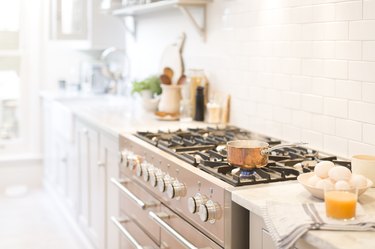Every household has at least one 240-volt appliance, and most have a power-hungry one, such as a stove, that draws 50 amps or more. That appliance connects to the panel via a double-pole 50-amp breaker. Whether you have to repair the breaker, or you're installing the circuit for the first time, you should know how to wire the breaker, even if you don't necessarily do it yourself.

Working in the Panel Is a Job for Pros
While replacing a breaker isn't difficult, it's dangerous. The panel is always energized, even if you turn off the main breaker, and even a slight mishap can result in a potentially fatal shock. For your own safety, refer any work inside the panel to a licensed electrician.
Video of the Day
Video of the Day
Two Basics of 240-Volt Wiring
Two characteristics of 240-volt wiring are important when you're installing a new circuit breaker. The first is that 240-volt wiring requires two hot wires, not just one as 120-volt circuits do. The second is that 240-volt circuits carry high-amp current. That means you need heavy-gauge wire to prevent overheating.
Each of the two hot wires requires its own breaker. Enter the double-pole breaker, which is in effect a pair of single-pole breakers stacked together. You need two adjacent empty slots in the panel to accommodate it.
The minimum wire gauge for a 50-amp breaker is eight gauge, and if the current draw is expected to remain close to the 50-amp limit for an extended period, you should use six-gauge wire. The three-conductor cable should have two hot wires that are colored red and black, a neutral wire that is colored white and a green or bare ground wire that doesn't count as a conductor.
Getting Ready for Installation
The panel has two hot buses, each with a potential of 120 volts between itself and the neutral bus and 240 volts between itself and the other hot bus. Each 120-volt light and appliance circuit wire connects to one of the hot buses.
It's important to spread the load evenly between these two buses for safety and efficiency. This is called balancing the panel, and it's something a qualified electrician will do before installing a new double-pole breaker. This is important to keep in mind if the panel is almost full, and you have to move a breaker to make space for the new double-pole breaker.
The Installation Procedure
After you've finished wiring your new device, which could be a 240-volt outlet for a stove or a new 50-amp RV plug, feed the wire into the panel through a knockout hole. Strip the cable, separate the wires and expose about 3/4 inch on the end of each one.
The white wire gets connected to the neutral bus, which is the chrome one to which all the other white wires are connected. The ground wire gets connected to the ground bus in the same way.
Wiring the Actual Breaker
Connect the red wire to one of the breaker lugs by loosening the lug with a screwdriver, inserting the end of the wire and tightening the lug. Connect the black wire to the other breaker in the same way. The wires are interchangeable; it doesn't matter to which breaker you attach either wire.
Once the wires are secure, you're ready to snap the breaker onto the panel. The actual procedure depends on the brand of panel, but usually you hook one end under a clamping bar and push on the breaker to seat it onto the bus bar. Once the breaker is seated and it's switched on, power is flowing through the circuit.